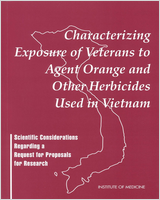NCBI Bookshelf. A service of the National Library of Medicine, National Institutes of Health.
Institute of Medicine (US) Committee on the Assessment of Wartime Exposure to Herbicides in Vietnam. Characterizing Exposure of Veterans to Agent Orange and Other Herbicides Used in Vietnam: Scientific Considerations Regarding a Request for Proposals for Research. Washington (DC): National Academies Press (US); 1997.

Characterizing Exposure of Veterans to Agent Orange and Other Herbicides Used in Vietnam: Scientific Considerations Regarding a Request for Proposals for Research.
Show detailsIn its 1994 report, Veterans and Agent Orange: Health Effects of Herbicides Used in Vietnam, the IOM Committee to Review the Health Effects in Vietnam Veterans of Exposure to Herbicides encountered a severe lack of information about the exposures of individual Vietnam veterans to herbicides and found that this lack of information had hampered previous attempts to study the effects of exposure to herbicides on the health of Vietnam veterans. The committee responsible for the 1994 report felt, however, that it might be possible to develop better methods of determining exposures among individual veterans by drawing on historic reconstructions. These methods may take into account such factors as troop movements, ground and perimeter spraying, herbicide shipments to various military bases, the type of terrain and foliage typical of the locations sprayed, the military missions of the troops located there, and biochemical techniques that can detect low levels of dioxin (a contaminant in some of the herbicides used in Vietnam) in the blood. If better models of exposure could be developed and validated, a number of important epidemiologic studies of exposure to herbicides and health outcomes might become possible.
The committee that wrote the 1994 report recognized that their recommendation for development of historic exposure reconstruction models might appear at variance with those of other research groups which expressed skepticism that such models could be produced (IOM, 1994:19–20). That committee offered four reasons for making the recommendation. First, it noted that the groups expressing concerns based their opinions in large part on the use of serum 2,3,7,8-tetrachlorodibenzo-p-dioxin (TCDD) measurements for validating exposure to herbicides used in Vietnam. The 1994 report committee felt that serum TCDD levels were insufficient for validating exposure, although they thought that such data might provide information useful to a larger validation effort (p. 289). Second, it observed that arguments against historic exposure reconstruction implied that exposure measurements might be imprecise, not that they were invalid. Third, the 1994 report committee noted that the use of more, but less formal, data on exposure than was considered by the previous groups—for example, data on perimeter spraying—might yield informative models. Finally, the committee noted that while it did not know whether the approach it proposed would prove valid or yield information useful for future epidemiologic studies, the likelihood that this approach would be successful was sufficient for it to be recommended.
- Background - Characterizing Exposure of Veterans to Agent Orange and Other Herbi...Background - Characterizing Exposure of Veterans to Agent Orange and Other Herbicides Used in Vietnam
Your browsing activity is empty.
Activity recording is turned off.
See more...